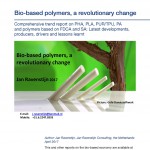The conversion from hydrocarbons to carbohydrates and CO2 as feedstock to produce chemicals and polymers becomes more significant every year. It is anticipated that bio-based chemicals like adipic acid, butanediol, furandicarboxylic acid, lactic acid and succinic acid will form bio-based chemical platforms worth more than 30 billion € by 2030. Although these chemicals are to a large extent used for polymer production, there are also other polymer related developments focusing on renewable feedstock use.
The comprehensive trend report presents latest developments, producers, drivers and lessons learnt especially for PHA, PLA, PUR/TPU, PA and polymers based on furandicarboxylic acid (FDCA) and succinic acid (SA).
Deutsche Version: https://renewable-carbon.eu/news/bio-basierte-polymere-eine-revolution
Polylactic acid (PLA) has left the embryonic stage for the early-growth stage of the S-curve, while Polybutylene succinate (PBSX) and Polyhydroxyalkanoates (PHAs) are still a phase behind that. The main bio-based activities for thermosets are in polyurethanes (PUR). The total PUR market is expected to be 30 billion € by 2020, while the bio-based part of this is ever increasing and expected to be 20% by that time. Although these polymers will most likely be partly bio-based, the availability of bio-based versions of all raw materials for PUR is growing strongly.
A common argument is that the introduction of bio-based materials is not going fast enough, but that clearly needs some nuancing: drop-in materials move very fast, provided their cost/performance-ratio is competitive with their fossil counterparts. After all, tedious application development programs are not needed. It’s a different story for new building blocks and polymers, since applications come one at the time – and we are never patient enough. However, the growth of bio-based succinic acid shows a quite normal pattern for new materials on the market.
Both chemo-catalytic and fermentative conversion technologies are being developed to produce renewable materials. In most cases the jury is still out on the best technology for some of the materials, like lactic acid, furans or butanediol.
The use of bio-waste streams and non-edible feedstock also plays an increasingly important role. Companies move towards these resources for cost reasons and to stay away from discussions on competition with the food chain and use of arable land.
Interestingly, more and more non-traditional players from the wood, paper, potato, sugar and other agricultural industries enter at the front end of the bio-based materials value chain. At the same time, several of the large traditional oil and chemical companies are also developing significant activities in this direction.
All these subjects are discussed and quantified in the new trend report “Bio-based polymers, a revolutionary change”, covering several bio-based monomers and polymers, their developers, producers and technologies, the drivers, new value chain alliances, volumes, prices and the most important lessons learnt from the early movers.
 Author of the trend report is the well-known polymer expert Jan Ravenstijn from the Netherlands.
Author of the trend report is the well-known polymer expert Jan Ravenstijn from the Netherlands.
The report is available at www.bio-based.eu/reports
Download ths press release as PDF file: 17-03-30 PR Bio-based polymer revolution
Source
nova-Institut GmbH, press release, 2017-03-30.
Share
Renewable Carbon News – Daily Newsletter
Subscribe to our daily email newsletter – the world's leading newsletter on renewable materials and chemicals









